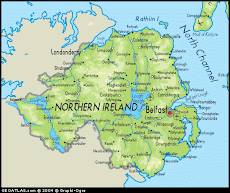So here’s a brief, nutshell version of the history of Northern Ireland.
Up until about the 1500’s Ireland was its own country, completely separate from England, Scotland and Wales. It was never really centrally governed, was solidly Roman Catholic in religion, Gaelic in culture, and largely uninfluenced by the English. It was, however, heavily influenced by Scotland, mostly due to geographic proximity.
Then came Martin Luther and his 90-some-odd thesis against the Catholic Church. While the Reformation swept across Western Europe, and Henry VIII was creating his own church, Ireland remained largely untouched. Roman Catholicism remained the predominate religion.
At the same time, England was busy colonizing the world. One of the first places to be colonized was its neighbor to the west, Ireland. At first, England was rather content to just let Ireland be, but England was now largely Anglican and Ireland was still largely Catholic, and this presented a problem: France and Spain—two of England’s enemies—were also mostly Catholic, and had Catholic rulers. England was afraid that Ireland would unite with France and Spain in an uprising against them. So in a political move called the “Plantation of Ulster,” British Parliament decided to reward the loyal nobles of England and Scotland (who are by this point united with Wales in the UK) with land taken from Irish natives. Again due to geographic proximity, a large amount of land in the northeast corner of the island went to Scottish nobles, who were also mostly Protestant. Some land was given out in the rest of Ireland, but it was concentrated mainly in the northeast. By moving the loyal nobles to the new colony, England hoped to gain political and religious control, and keep Ireland out of an alliance with France and Spain.
For the next hundred years or so, Ireland continued to be taken over by English and Scottish nobles and the descendants of the original Plantation movement. There were many small uprisings and skirmishes throughout the 1700’s between the native Irish who were being pushed off their own land, and the new nobles and nobles’ descendants, but these were almost always easily and quickly dealt with by the British military. In the early-1800’s Ireland was joined with Great Britain as part of one United Kingdom, but there was continuing and growing unrest.
In the early 1900’s there was a growing sentiment for Irish home rule. The descendants of the original nobles in the Plantation, however, were strongly against home rule because if Ireland became its own country it would mean that the demographics would shift heavily towards Catholicism and native Irish culture, meaning that then they would be the minority religiously, culturally and—most importantly—politically. The saying at the time was, “Home Rule equals Rome Rule.” In 1920 it was finally decided that the counties in the northeast corner of the island—known as Ulster—who were largely pro-British and Protestant (labeled Unionists), would be partitioned off to stay with the UK, while the largely Catholic, pro-Irish population on the rest of the island (labeled Nationalists) would be granted sovereignty. The problem with this was that the population was not so neatly divided between Ulster and Ireland, and neither were sentiments; both sides had people who felt they were being left out and cheated. Nevertheless, Ulster was partitioned off to become Northern Ireland and a part of the UK, while the rest of the island became the Republic of Ireland.
Paramilitary groups were popular and many rose up on either side of the conflict, organizing and gaining momentum (and weaponry) to use force to make their points. The Ulster Volunteer Force actually took up arms AGAINST their own independence. This civil war was interrupted by World War One, where the Ulster Volunteer Force, along with many other groups and military forces, joined the war effort and suffered huge casualties. Also, during this time, there was a brief uprising in Ireland of the Irish Republican Army. They engaged the British military in an attempted coup, where they were defeated; key members were arrested and publicly executed. Instead of acting as a warning, their executions made them martyrs which only served to raise the proverbial battle flag and support the IRA’s cause. People continued to join forces on one “side” or the other which led to increasing tension.
During the 1960’s and 70’s there was a worldwide movement for civil rights. In Northern Ireland, there had been a complete overhaul of the education system, which meant that the Nationalists had more of an opportunity for higher education; something they had not had before. Graduates were now more informed, more empowered, and were becoming the catalysts for change. The Nationalists especially were pushing for change towards home rule, however, the Unionists, by virtue of numbers, dominated everything from politics and religion to housing. The push for change was met with violence; Unionists resisted Nationalist efforts which only made Nationalists push harder.
In the mid 70’s the Troubles (as the back and forth paramilitary struggle became known and is known as today) hit a peak. Homemade bombs, gunfights, bricks through windows were all too common throughout Northern Ireland and Belfast, especially at interfaces (areas where Protestant neighborhoods and Catholic neighborhoods border each other.) Acts of terrorism were everyday events from paramilitary groups which made cease fire talks between official governing bodies nearly impossible. The Troubles began to decline in severity in the early 80’s but continued into the late 90’s and early 2000’s. Finally in 1998, an agreement was reached to give Northern Ireland a certain amount of autonomy to decide for itself where it should belong. The Republic of Ireland agreed not to pull it from Britain by force, and Britain agreed not to make it stay should it choose to leave. So far, by general election, the people of Northern Ireland have chosen to stay with Britain.
Today the issues of conflict mostly reside with fear and power; fear of people losing their identities since they have had generations to become comfortable where they are, and the reluctance to share power (or relinquish power) with (to) the perceived “enemy.” Another enemy in Northern Ireland today is complacency. Since bombings, shootings and other acts of violence are not nearly as common as they once were, many people are happy to just stay where they are and live in a permanent cease-fire state. “Don’t rock the boat” is a too-common sentiment. Fortunately, “What can we do?” is also a common sentiment. I have been very impressed with many of the people we have met through our site placements who see this divisive society, not as a huge obstacle, but as a challenge and opportunity for growth. Utilizing youth programs, sports, the arts, clubs, schools and community centers, people are willingly reaching out to “the other.” Several of our sites are near interfaces and at least two—Macrory and Whitehouse—sit directly on the lines. While the building placement might not have been originally intentional, the programming now definitely is: ALL people are children of God, deserve love, respect and dignity, and we are called as Christians to do something.
That brings us up to Northern Ireland today. Like I said earlier, this is just a very brief, nutshell version of the history here, and there are many more layers and themes that add to what makes life here the way it is. Hopefully this gives you a better idea of why I am here, and why peacemaking and reconciliation ministry is so important. I hope to soon post more about the recent events and shed some light on peace walls and murals, but in the meantime, I’ll let you digest this.
Two slight ammendments to make:
1) The Scottish nobles who received land in Ireland from the English, weren't exactly nobles so much as they were just loyal British subjects.
2) One of the major differences between the colonization of Ireland and the colonization of so many other places--and one of the factors that led to the Troubles--was that the colonizers never became the majority. So often, the colonizing population eventually outgrew the native population in numbers as well as in political and religious prowess. (See the conflict between Europeans and Native Americans in the States in the late 1700's-early 1800's.) This never happened in Ireland, so the native population remained the majority in numbers, but not necessarily in politics and religion.






